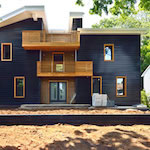DETAILS
Location Paramus, NJ
Program Renovation of a single-family residence
Size 4,000 ft2
Completion 2014 (expected)
Certification International Passive House Standard, LEED Platinum, Net Zero Energy, MBDC Cradle to Cradle (all expected)
Climate Mesothermal
Architect Erik Velez and Hitesh Parikh
Passive House Consultant / General Contractor Asit Parikh
Owner Raj Parikh
Insulation Foamglas
The home at 279 Henry Street in Paramus, New Jersey, started its life in 1949 as a 1,800-square-foot, rectangular residence. Sixty-five years later, its owner and engineer, Metropolitan Building Consulting Group CEO Raj Parikh, is rebuilding it as Zenesis House, a 4,000-square-foot, LEED Platinum and Passive House-certified home that harvests wind and solar energy, maximizes heat exchange with the ground, and collects and purifies water and snowmelt.
Asit Parikh, Raj’s son and a green development real estate agent at Nest Seekers International, served as the project’s general contractor and Passive House consultant. The two wanted to demonstrate that a house could be retrofitted as a standard in green living for the same cost as tearing down and reconstructing a new home. “The project was fairly expensive, but when you take into account the many ways a Passive House makes a home more affordable in the long term, it was absolutely cost effective,” Asit says.
Raj knew he wanted to build a house that set new standards in the green building industry, but practical concerns were important to him. A typical complaint of Passive House buildings is that the internal temperature is at a constant that can’t be adjusted, but Parikh took this into consideration with his design. In addition, the net-zero-energy home houses a three-story indoor living wall that filters air, maintains humidity, and offers year-round indoor gardening.

A key feature that will enable Zenesis to achieve Passive House and LEED certification is Foamglas, a cellular glass insulator that is flame, moisture, and insect resistant.
A key feature that will enable Zenesis to achieve Passive House and LEED certification is Foamglas, a cellular glass insulator that is flame, moisture, and insect resistant. Pittsburgh Corning Corporation manufactures Foamglas from sand, producing molten glass that is passed through a cellulating oven and heated to create insulated blocks. These blocks can be cut down for use on roofs, walls, foundations, footing, and slabs and are free of toxins like HCFCs, CFCs, and HFCs.
Cameo Morningstar, the Northeast regional manager at Foamglas, helped Raj envision the possibilities in Zenesis. He recalls Morningstar demonstrating how to install Foamglas in the Zenesis House, showing off her muscles and know-how. “When we calculated everything, it became clear that Foamglas was the only material I could use and still achieve all of the standards I had envisioned,” he says.
Raj hopes Zenesis House will give builders ideas for different projects that they can incorporate into a green home, even if they can’t build everything he has created. Using a combination of solar and geothermal energy, he adds, is a way to make Passive Houses more comfortable and, hopefully, more appealing to homeowners.

